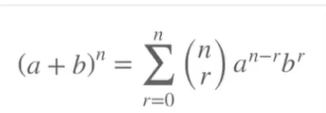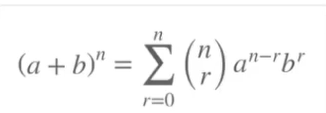Spot on. I was just playing about finding one way to solve both types of questions.Using a double sum for this is like using a nuke to crack a walnut but what the heck.
[math](1 - 3x)(1 + 3x)^6 = \sum_{j = 0}^1 \binom{1}{j} (1)^j (-3x)^{1-j} \sum_{k = 0}^6 \binom{6}{k} (1)^k (3x)^{6 - k}[/math]
[math]= \sum_{j = 0}^1 \sum_{k = 0}^6 \binom{1}{j} \binom{6}{k} (-3x)^{1-j} (3x)^{6 - k}[/math]
[math]= \sum_{j = 0}^1 \sum_{k = 0}^6 \binom{1}{j} \binom{6}{k} (-1)^{1 - j} 3^{7 -j - k} x^{7 - j - k}[/math]
For the [imath]x^3[/imath] term, pick out j, k such that 7 - j - k = 3. Well, j only goes from 0 to 1, so when j = 0, k = 4 and when j= 1 then k = 3. So the coefficient of [imath]x^3[/imath] will be
[imath]\binom{1}{0} \binom{6}{4} (-1)^{1 - 0} 3^{7 -0 - 4} + \binom{1}{1} \binom{6}{3} (-1)^{1 - 1} 3^{7 -1 - 3}[/imath]
But it's simpler just to distribute:
[math](1 - 3x)(1 + 3x)^6 = \sum_{k = 0}^6 \binom{6}{k} (1)^k (3x)^{6 - k} + \sum_{k = 0}^6 \binom{6}{k} (1)^k (-3x) (3x)^{6 - k}[/math]
and go from there.
-Dan
You are using an out of date browser. It may not display this or other websites correctly.
You should upgrade or use an alternative browser.
You should upgrade or use an alternative browser.
What have I done wrong here with this binomial expansion?
- Thread starter Smith S.
- Start date
@topsquark Isn't this the  theorem? Why are the letters and notations switched?
theorem? Why are the letters and notations switched?
 theorem? Why are the letters and notations switched?
theorem? Why are the letters and notations switched?pka
Elite Member
- Joined
- Jan 29, 2005
- Messages
- 11,991
They are identical:[imath]{(a + b)^r} =\displaystyle{ \sum\limits_{r = 0}^n {\dbinom{n}{r}{a^r}{b^{n - r}}} = \sum\limits_{r = 0}^n {\dbinom{n}{r}{a^{n - r}}{b^r}}} [/imath]@topsquark Isn't this the View attachment 33393theorem? Why are the letters and notations switched?
Look at the symmetry: [imath](a+b)^6=a^6 + 6 a^5 b + 15 a^4 b^2 + 20 a^3 b^3 + 15 a^2 b^4 + 6 a b^5 + b^6[/imath]
topsquark
Senior Member
- Joined
- Aug 27, 2012
- Messages
- 2,393
They are the same. My notation would give [imath](a + b)^2 = b^2 + 2ab + a^2[/imath] whereas yours gives [imath](a + b)^2 = a^2 + 2ab + b^2[/imath]. Honestly I should stick with one form or the other but I write down whichever pops out of my head first. It works out the same in the end.@topsquark Isn't this the View attachment 33393theorem? Why are the letters and notations switched?
-Dan
Cubist
Senior Member
- Joined
- Oct 29, 2019
- Messages
- 1,690
Just remember that one of the exponents (it doesn't matter which one) goes from r=0 to n {0,1,2...n} and the other must go in reverse {n,...2,1,0} which means each element is (n-r)Yeah, they are the same; I got the same answer. How do you remember the binomial theorem and not just one but the other variant of it too?
And within the binomial "choose" function, the number on top is always greater or equal to the one below. Therefore, it must be "n" above "r"
Steven G
Elite Member
- Joined
- Dec 30, 2014
- Messages
- 14,598
Why are you trying to do all this?
(1-x/3)(1+3x)^6 = 1(1+3x)^6 - (x/3)(1+3x)^6
What is the x^3 term of 1(1+3x)^6: 20*1^3*(3x)^3 = ....
What is the x^3 term of (x/3)(1+3x)^6. You just need to find the x^2 term of (1+3x)^6: 15(1)^4(3x)^2 =...
Continue!
(1-x/3)(1+3x)^6 = 1(1+3x)^6 - (x/3)(1+3x)^6
What is the x^3 term of 1(1+3x)^6: 20*1^3*(3x)^3 = ....
What is the x^3 term of (x/3)(1+3x)^6. You just need to find the x^2 term of (1+3x)^6: 15(1)^4(3x)^2 =...
Continue!
topsquark
Senior Member
- Joined
- Aug 27, 2012
- Messages
- 2,393
He isn't factoring, he's distributing... (1 - 3x) (a + bx) = 1 (a + bx) - 3x (a + bx). It's the same thing that I've been doing with the summation notation.@Steven G I actually don't understand why you are factoring. However, I understand both the methods presented by topsquark.
-Dan
Steven G
Elite Member
- Joined
- Dec 30, 2014
- Messages
- 14,598
I did not factor, I distributed. You just need to find the coefficient of x^3 for 1(1+3x)^6 and then subtract the coefficient of x^3 for (x/3)(1+3x)^6@Steven G I actually don't understand why you are factoring. However, I understand both the methods presented by topsquark.
topsquark
Senior Member
- Joined
- Aug 27, 2012
- Messages
- 2,393
Okay, first. The distributive property of multiplication over addition: a(b + c) = ab + ac. We can use this do derive things like the FOIL rule:Expand on it please. I do understand this 1 (a + bx) - 3x (a + bx). But how is distributing the same thing to the summation notation?
(a + b)(c + d) = a(c + d) + b(c + d)
So [imath](1 - 3x)(1 + 3x)^6 = 1(1 + 3x)^6 + (-3x)(1 + 3x)^6[/imath]
When we write [imath](1 - 3x)^n (1 + 3x)^m[/imath] we actually are distributiing:
[math](1 - 3x)^n (1 + 3x)^m = \sum_{k = 0}^m \binom{m}{k} (1)^{m - k} (-3k)^k \sum_{j = 0}^n \binom{n}{j} (1)^{n - j} (3k)^j[/math]
[math]= \left ( \binom{n}{0} (1)^{n-0} (-3x)^{0} + \binom{m}{1} (1)^{n-1} (-3x)^1 + \text{ ... } + \binom{n}{1} (1)^0 (-3x)^n \right ) \times \left ( \binom{m}{0} (1)^{m-0} (3x)^0 + \binom{m}{1} (1)^{m-1} (3x)^1 + \text{ ... } + \binom{m}{1} (1)^0 (3x)^m \right )[/math]
[math]= 1 \left ( \binom{m}{0} (3x)^0 + \binom{m}{1} (3x)^1 + \text{ ... } + \binom{m}{1} (3x)^m \right ) + \binom{m}{1} (-3x)^1 \left ( \binom{m}{0} (3x)^0 + \binom{m}{1} (3x)^1 + \text{ ... } + \binom{m}{1} (3x)^m \right )+ \text{ ...}[/math]
When we are doing something like [imath](1 - 3x)^5(1 + 3x)^6[/imath] then, yes, it makes a lot of sense to use the summation version. But if you are doing [imath](1 - 3x)(1 + 3x)^6 = (1 +3x)^6 + (-3x)(1 + 3x)^6[/imath] just distributing directly is faster and less complicated..
-Dan
Bad luck for the neighbors and an inconvenience during the monsoon.You'll more than kill the mosquito. You'll put a hole through the wall where the
mosquito was.
Kulla_9289
Junior Member
- Joined
- Apr 18, 2022
- Messages
- 223
@topsquark Could you please solve this using the double summation method (to satiate my curiosity):
? This was the original question posted by the original poster.
Code:
(1-x/3)(1+3x)^6topsquark
Senior Member
- Joined
- Aug 27, 2012
- Messages
- 2,393
See post #14. It's the same concept. Just use x/3 instead of 3x and only sum from 0 to 1 in the first summation:@topsquark Could you please solve this using the double summation method (to satiate my curiosity):
? This was the original question posted by the original poster.Code:(1-x/3)(1+3x)^6
[math]\left ( 1 - \dfrac{x}{3} \right ) (1 + 3x )^6 = \sum_{j =0}^1 \binom{1}{j} (1)^j \left ( -\dfrac{x}{3} \right )^{1- j} \sum_{k = 0}^6 \binom{6}{k} (1)^k (3x)^{6 - k}[/math]
-Dan
Kulla_9289
Junior Member
- Joined
- Apr 18, 2022
- Messages
- 223
@topsquark Could you please show a step-by-step solution on finding the x^3 term? I have hit an impasse due to the fraction. Thank you.See post #14. It's the same concept. Just use x/3 instead of 3x and only sum from 0 to 1 in the first summation:
[math]\left ( 1 - \dfrac{x}{3} \right ) (1 + 3x )^6 = \sum_{j =0}^1 \binom{1}{j} (1)^j \left ( -\dfrac{x}{3} \right )^{1- j} \sum_{k = 0}^6 \binom{6}{k} (1)^k (3x)^{6 - k}[/math]
-Dan
topsquark
Senior Member
- Joined
- Aug 27, 2012
- Messages
- 2,393
You are looking for two factors. The first will give you x^(1 - j) and the second will give you x^(6-k). When they add they will give 3. So@topsquark Could you please show a step-by-step solution on finding the x^3 term? I have hit an impasse due to the fraction. Thank you.
1 - j + 6 - k = 3
-j - k = -4
j + k = 4
Since j can only be 0 and 1 what are the possible values of k? So pick out those coefficients and add them.
-Dan
Cubist
Senior Member
- Joined
- Oct 29, 2019
- Messages
- 1,690
I have hit an impasse due to the fraction
I assume that you're talking about the 1/3? If so, then would it help to change the fraction (shown in red)...
to this...[math]\left ( 1 - \dfrac{x}{\red{3}} \right ) (1 + 3x )^6 = \sum_{j =0}^1 \binom{1}{j} (1)^j \left ( -\dfrac{x}{\red{3}} \right )^{1- j} \sum_{k = 0}^6 \binom{6}{k} (1)^k (3x)^{6 - k}[/math]
[math]\left ( 1 - \red{c}x \right ) (1 + 3x )^6 = \sum_{j =0}^1 \binom{1}{j} (1)^j \left ( -\red{c}x \right )^{1- j} \sum_{k = 0}^6 \binom{6}{k} (1)^k (3x)^{6 - k}[/math]
Then, after solving, you'd just put c=1/3 back into the result to obtain the final answer
EDIT: Combine this with the advice in post#39 and hopefully you'll be able to complete the problem.

